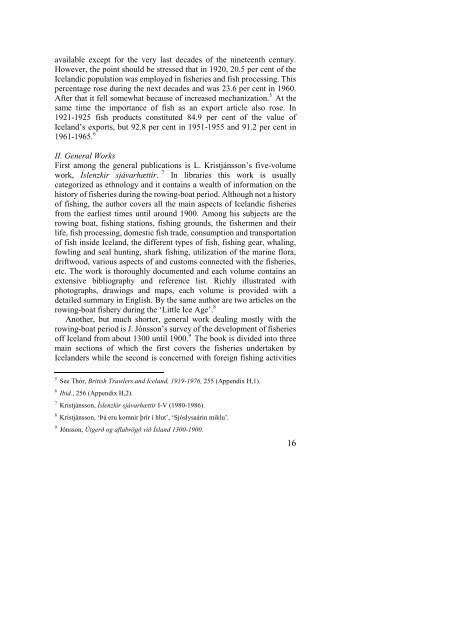The North Atlantic Fisheries, 1100-1976 - University of Hull
The North Atlantic Fisheries, 1100-1976 - University of Hull
The North Atlantic Fisheries, 1100-1976 - University of Hull
You also want an ePaper? Increase the reach of your titles
YUMPU automatically turns print PDFs into web optimized ePapers that Google loves.
available except for the very last decades <strong>of</strong> the nineteenth century.<br />
However, the point should be stressed that in 1920, 20.5 per cent <strong>of</strong> the<br />
Icelandic population was employed in fisheries and fish processing. This<br />
percentage rose during the next decades and was 23.6 per cent in 1960.<br />
After that it fell somewhat because <strong>of</strong> increased mechanization. 5 At the<br />
same time the importance <strong>of</strong> fish as an export article also rose. In<br />
1921-1925 fish products constituted 84.9 per cent <strong>of</strong> the value <strong>of</strong><br />
Iceland’s exports, but 92.8 per cent in 1951-1955 and 91.2 per cent in<br />
1961-1965. 6<br />
II. General Works<br />
First among the general publications is L. Kristjánsson’s five-volume<br />
work, Íslenzkir sjávarhættir. 7<br />
In libraries this work is usually<br />
categorized as ethnology and it contains a wealth <strong>of</strong> information on the<br />
history <strong>of</strong> fisheries during the rowing-boat period. Although not a history<br />
<strong>of</strong> fishing, the author covers all the main aspects <strong>of</strong> Icelandic fisheries<br />
from the earliest times until around 1900. Among his subjects are the<br />
rowing boat, fishing stations, fishing grounds, the fishermen and their<br />
life, fish processing, domestic fish trade, consumption and transportation<br />
<strong>of</strong> fish inside Iceland, the different types <strong>of</strong> fish, fishing gear, whaling,<br />
fowling and seal hunting, shark fishing, utilization <strong>of</strong> the marine flora,<br />
driftwood, various aspects <strong>of</strong> and customs connected with the fisheries,<br />
etc. <strong>The</strong> work is thoroughly documented and each volume contains an<br />
extensive bibliography and reference list. Richly illustrated with<br />
photographs, drawings and maps, each volume is provided with a<br />
detailed summary in English. By the same author are two articles on the<br />
rowing-boat fishery during the ‘Little Ice Age’. 8<br />
Another, but much shorter, general work dealing mostly with the<br />
rowing-boat period is J. Jónsson’s survey <strong>of</strong> the development <strong>of</strong> fisheries<br />
<strong>of</strong>f Iceland from about 1300 until 1900. 9 <strong>The</strong> book is divided into three<br />
main sections <strong>of</strong> which the first covers the fisheries undertaken by<br />
Icelanders while the second is concerned with foreign fishing activities<br />
5 See Thór, British Trawlers and Iceland, 1919-<strong>1976</strong>, 255 (Appendix H,1).<br />
6 Ibid., 256 (Appendix H,2).<br />
7 Kristjánsson, Íslenzkir sjávarhættir I-V (1980-1986).<br />
8 Kristjánsson, ‘Þá eru komnir þrír í hlut’, ‘Sjóslysaárin miklu’.<br />
9 Jónsson, Útgerð og aflabrögð við Ísland 1300-1900.<br />
16















